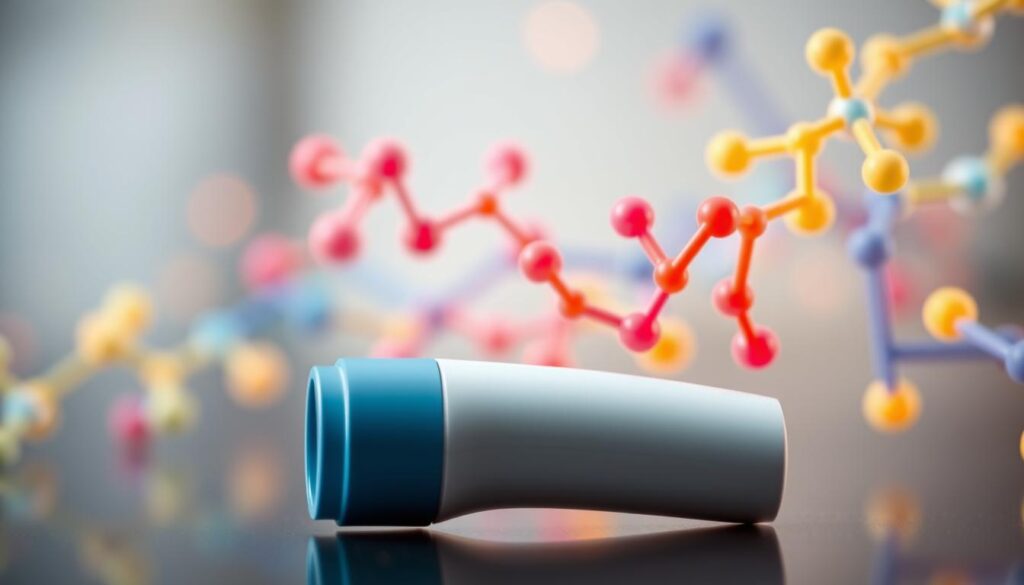Are you thinking about peptide therapy and wondering if nasal inhaler peptides are better than injectables? The answer is yes. Nasal inhaler peptides offer many benefits that make them a great choice for many people. They eliminate the pain and discomfort of injections and are easier to use.
Nasal inhaler peptides can get past the blood-brain barrier to reach the brain. This is hard for injectables to do because of the barrier’s tightness. Nasal-to-brain delivery is quick, targeted, and reduces side effects.
Also, nasal inhaler peptides are cheaper and easier to use than injectables. No needles or syringes are needed. This makes therapy more affordable and less scary for patients.
Exploring nasal inhaler peptides can lead to safer and more effective peptide therapy. They can help manage health issues, improve physical performance, or boost overall well-being. Nasal peptide inhalers might be the answer you’ve been looking for.
Challenges of Delivering Peptides to the Brain
Developing peptide-based treatments faces a big hurdle: getting peptides past the blood-brain barrier (BBB). The BBB’s tight junctions make it hard for peptides to pass through. Plus, the presence of drug efflux proteins makes it even tougher.
Limitations of Oral and Parenteral Administration
Peptides given orally don’t get absorbed well and are quickly broken down by the stomach. This means they often need to be given by injection. But, injections are invasive and can be painful, making them hard for patients to accept.
Most peptides don’t stay in the body long enough to reach the brain. They need special carriers to get past the BBB.
Blood-Brain Barrier and Peptide Permeability
The blood-brain barrier acts as a protective shield around the brain. It keeps harmful substances out. But, it also blocks the penetration of peptides into the brain.
This barrier is made up of tight junctions and efflux transporters. These features make it hard for peptides to get to the brain. Finding ways to overcome these barriers is crucial for treating brain disorders with peptides.

Advantages of Nasal Inhaler Peptides
Nasal inhaler peptides have many benefits over traditional injectables. They can bypass the blood-brain barrier. This is because the nasal route uses the olfactory and trigeminal nerves in the upper nasal cavity.
Bypassing the Blood-Brain Barrier
The blood-brain barrier (BBB) blocks many molecules, including therapeutic peptides, from entering the brain. Nasal administration lets you skip the BBB. This way, peptides can quickly and easily reach the CNS.
Rapid and Non-Invasive Delivery to the CNS
Nasal inhaler peptides are a simple and friendly way to get therapeutic agents to the CNS. This easy method means no injections, lowering the risk of problems and making patients more likely to stick with treatment. Peptides are quickly absorbed through the nasal mucosa, leading to quicker action than other methods.
The advantages of nose-to-brain delivery for peptide therapy include less plasma exposure and fewer side effects. It also avoids the liver’s first pass, allowing for lower drug doses to achieve the same effect.

Nasal Anatomy and Pathways for Peptide Delivery
Knowing the nasal cavity’s detailed anatomy is key for effective peptide delivery. It acts as a gateway. This allows substances to enter the brain and the body’s circulation.
Olfactory and Trigeminal Nerve Pathways
The nasal cavity is split into two halves by the middle septum. It opens at the face and goes back to the nasopharynx. The nasal cavity has three main areas: the nasal vestibule, the respiratory region, and the olfactory region.
The olfactory and trigeminal nerves are crucial for peptide transport. The olfactory nerve pathway lets substances reach the olfactory bulb, part of the brain. The trigeminal nerve pathway connects the nasal cavity to the brainstem, offering another delivery route.
These nerve paths, along with the nasal cavity’s anatomy, make intranasal delivery promising. It allows peptides to directly reach the brain, improving treatment results and reducing side effects.
The table below summarizes the key features of the nasal anatomy and its relevance for peptide delivery:
| Feature | Relevance for Peptide Delivery |
| — | — |
| Nasal Vestibule | Closer to the nostrils, provides initial exposure to inhaled substances |
| Respiratory Region | Responsible for breathing and air conditioning |
| Olfactory Region | Contains olfactory tissue, acts as a gateway to the brain |
| Olfactory Nerve | Provides a direct pathway to the olfactory bulb and CNS |
| Trigeminal Nerve | Connects the nasal cavity to the brainstem, offering an alternative route |
By grasping the nasal cavity’s anatomy and nerve pathways, experts can better deliver peptides. This targets specific brain areas, making intranasal administration more effective.
nasal inhaler peptides vs. injections: cost savings on supplies
Nasal inhaler peptides are cheaper than injectable forms. They don’t need needles or syringes, making them easier to use. This saves money for both patients and healthcare systems.
The market for peptide drugs is growing fast, expected to hit $50 billion by 2024. Most peptides are given through injections, with subcutaneous being the most common. This shows the big role injectables play in delivering peptides.
Nasal inhaler peptides, however, are more affordable. The market for nasal medications is over $6 billion and growing fast. This shows how popular and cost-effective nasal inhalers are becoming.
| Formulation Type | Percentage of Total Injections |
|---|---|
| Subcutaneous | 36% |
| Intravenous | 26% |
| Intramuscular | 14% |
Nasal inhaler peptides save a lot of money by not needing needles or syringes. This makes them a better choice for patients and healthcare systems. It also helps more people get access to these treatments.
Clinical Applications and Therapeutic Benefits
Nasal inhaler peptides have many uses in medicine. They help with neurological disorders and managing chronic pain. They can reach the brain directly, which is a big advantage for treating certain conditions.
Treatment of Neurological Disorders
Peptides delivered through the nose can be very effective. They can help with psychiatric disorders, neurodegeneration, and chronic pain. Studies have shown they can improve mood and reduce stress.
Pain Management and Chronic Conditions
Nasal inhaler peptides are also good for pain relief and treating chronic conditions. This method is easy and affordable for patients. It’s a great option for managing long-term health issues.
More research is needed, but the results are promising. Nasal inhaler peptides could change how we treat many health problems.
Conclusion
Nasal inhaler peptides are a better choice than injectable peptides. They can get past the blood-brain barrier easily. This makes them a great option for many health issues.
The nasal cavity’s special nerves help peptides reach the brain quickly. This is a big plus over other ways of getting medicine into the body. It’s also cheaper to use nasal inhalers, which is good for both doctors and patients.
This method is very promising for treating many health problems. It could make treatments work better and help patients feel better faster. As peptide therapy keeps getting better, nasal inhalers will play a big role in improving health care.










